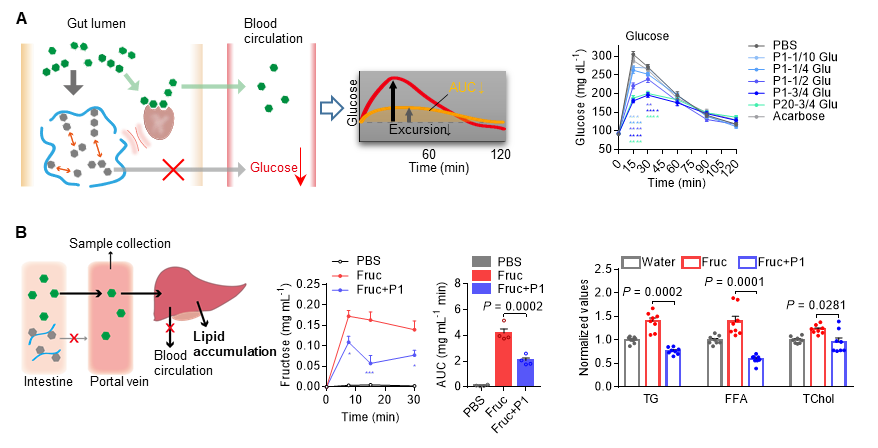


The team led by Shiyi Zhang from School of Biomedical Engineering made a major discovery: orally administered saccharide-sequestering nanocomplex to manage carbohydrate metabolism disorders
April 08, 2021
Overnutrition has been a growing global health threat. Excessive sugar intake increases the disease burden of cardiovascular disease, diabetes, obesity, nonalcoholic fatty liver disease (NAFLD), and other metabolic disorders. Policy-making and patient education on sugar restriction have only limited effect, while technical breakthroughs in medication await. As the only Food and Drug Administration (FDA)–approved medication for limiting sugar intake, the α-glucosidase inhibitor(mainly acarbose) is ineffective to monosaccharides (e.g., glucose and fructose), which limits its clinical usage for people adhering to the Western diet. Beyond diabetes, excessive consumption of fructose has a tight association with NAFLD, nonalcoholic steatohepatitis (NASH), and many other diseases. However, there is no drug approved or in clinical studies that act to limit the fructose intake.
Therefore, the team led by Shiyi Zhang report the first example of an orally administered polymer nanocomplex (Nano-Poly-BA) for preventing saccharide absorption in the GI tract by serving as a dynamic covalent nano-sequestrant for all types of saccharides. Negative charge and/or PEG unit on Poly-BA render nonabsorbed and nonfouling properties, thereby providing a zero systemic exposure and an ideal safety profile. Poly-BA self-assembles into nanostructures in water and serves as the sponge to absorb a large number of saccharides through dynamic bonds. The hierarchical design from molecular level to nano level is highly customizable, owing to the enriched monomer library and one-pot polymer chemistry, and may lead to extensive applications by controlling the absorption of the widely existing saccharide analogs as nutrients, drugs, toxins, and even glycosylated biomolecules for other medical needs. This study named “Orally administered saccharide-sequestering nanocomplex to manage carbohydrate metabolism disorders” was published in the journal science advances.

Figure 1: Schematic diagram of drug mechanism: The polymer binds to sugar molecules and prevents the enzymatic hydrolysis and absorption of sugar molecules, thereby regulate blood sugar after eating

Figure 2: (A)Decrease blood sugar after eating (B) Reduces fructose absorption and lipid hoarding in the liver due to fructose metabolism
The first author of this study is Xin Zhao, a postdoctoral fellow at the School of Biomedical Engineering, Shanghai Jiao Tong University. The corresponding author is Shiyi Zhang, School of Biomedical Engineering, Shanghai Jiao Tong University. The team led by ShiYi Zhang is committed to solving clinical problems, and its main research directions include cancer adjuvant treatment, diabetes, and chronic kidney disease, etc. Currently, one drug is in clinical phase 2, and several drugs are in the IND application stage in their research group.
Original paper link: https://advances.sciencemag.org/content/advances/7/14/eabf7311.full